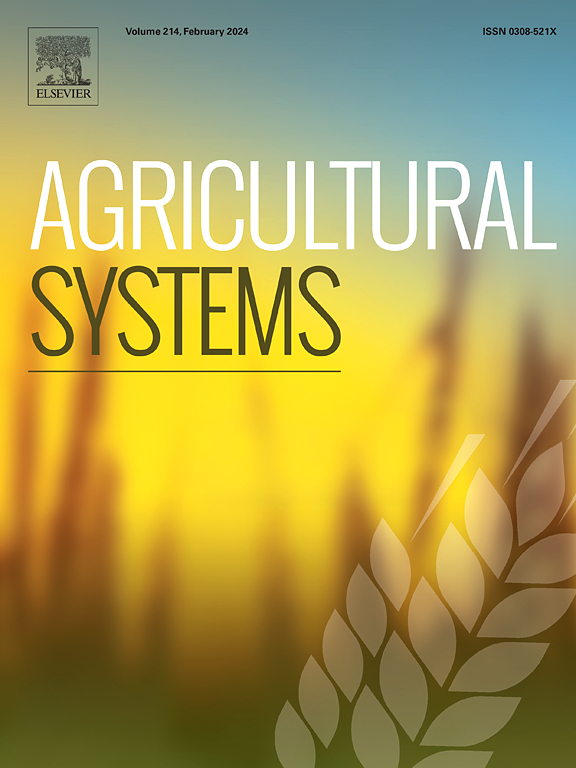农业系统的轨迹重塑了加拉帕戈斯群岛农业区的土地利用/土地覆盖动态
IF 6.1
1区 农林科学
Q1 AGRICULTURE, MULTIDISCIPLINARY
引用次数: 0
摘要
背景了解土地利用和土地覆盖动态对粮食安全和生物多样性保护至关重要,特别是在像加拉帕戈斯群岛这样脆弱的岛屿生态系统中。在高原农业区,这些动态是复杂的社会生态相互作用的结果,涉及耕作方式、劳动力结构和物种入侵等生态压力。本研究旨在探讨农业系统轨迹如何影响加拉帕戈斯农业区的土地利用价值变化,旨在确定影响土地转型的关键趋势和社会经济驱动因素及其对可持续性的影响。方法采用基于遥感的LULC分类(2018-2024)与农业普查数据(2000年、2014年和2022年)的多元分析相结合的综合方法。空间分析量化了土地覆盖变化,同时利用协调和聚类技术评估了耕作系统的变化。结果和结论研究结果表明,大约41%的农业用地仍处于生产利用状态(多年生作物、一年生作物和牧场),其中圣克鲁斯和伊莎贝拉超过了50%。在2018年至2024年期间,多年生作物减少了33%,而一年生作物增加了92%,反映出作物专业化的转变和多样化混合系统的增加。这些转变的主要驱动因素包括女性劳动参与率的提高(从2%提高到20%)、家庭性别角色、作物多样性、市场导向和协会成员资格。然而,土地撂撂率仍高达16%,入侵物种,特别是在圣克鲁斯,继续威胁着农业生态系统的恢复能力。必须指出,虽然普查数据主要反映生产性农场,但遥感分析包括整个农业区,包括废弃和边缘地块。这种范围上的差异解释了两种方法之间的一些差异,并强调了它们的互补价值。本研究强调了整合遥感和社会经济数据在监测土地利用转变、为适应性和可持续土地管理政策提供信息、加强入侵物种控制以及支持加拉帕戈斯群岛等脆弱岛屿生态系统的粮食主权和生物多样性保护方面的价值。本文章由计算机程序翻译,如有差异,请以英文原文为准。

Trajectories of farming systems reshape land use/land cover dynamics in the agricultural zones of the Galapagos Islands
CONTEXT
Understanding land use and land cover (LULC) dynamics is essential for food security and biodiversity conservation, particularly in fragile island ecosystems like the Galapagos. In the highland agricultural zones, these dynamics result from complex socio-ecological interactions involving farming practices, labor structures, and ecological pressures such as invasive species.
OBJECTIVE
This study investigates how farming system trajectories influence LULC changes in the Galapagos agricultural zones, aiming to identify key trends and socio-economic drivers shaping land transformations and their implications for sustainability.
METHODS
We applied an integrated approach that combines remote sensing-based LULC classification (2018–2024) with multivariate analysis of farm census data (2000, 2014, 2022). Spatial analysis quantified land cover changes, while shifts in farming systems were assessed using ordination and clustering techniques.
RESULTS AND CONCLUSIONS
Findings reveal that approximately 41 % of the agricultural land remains under productive use (perennial crops, annual crops, and pastures), with Santa Cruz and Isabela surpassing 50 %. Between 2018 and 2024, perennial crops declined by 33 %, while annual crops expanded by 92 %, reflecting a shift towards crop specialization and an increase in diversified mixed systems. Key drivers of these transitions include rising female labor participation (from 2 % to 20 %), household gender roles, crop diversity, market orientation, and association membership. However, land abandonment persists at 16 %, and invasive species, particularly in Santa Cruz, continue to threaten agroecosystem resilience. It is important to note that, while the census data mainly reflect productive farms, the remote sensing analysis encompasses the entire agricultural zones, including abandoned and marginal parcels. This difference in scope explains some discrepancies between both approaches and underscores their complementary value.
SIGNIFICANCE
This study underscores the value of integrating remote sensing and socio-economic data to monitor land use transitions, inform adaptive and sustainable land management policies, enhance invasive species control, and support both food sovereignty and biodiversity conservation in fragile island ecosystems like Galapagos.
求助全文
通过发布文献求助,成功后即可免费获取论文全文。
去求助
来源期刊

Agricultural Systems
农林科学-农业综合
CiteScore
13.30
自引率
7.60%
发文量
174
审稿时长
30 days
期刊介绍:
Agricultural Systems is an international journal that deals with interactions - among the components of agricultural systems, among hierarchical levels of agricultural systems, between agricultural and other land use systems, and between agricultural systems and their natural, social and economic environments.
The scope includes the development and application of systems analysis methodologies in the following areas:
Systems approaches in the sustainable intensification of agriculture; pathways for sustainable intensification; crop-livestock integration; farm-level resource allocation; quantification of benefits and trade-offs at farm to landscape levels; integrative, participatory and dynamic modelling approaches for qualitative and quantitative assessments of agricultural systems and decision making;
The interactions between agricultural and non-agricultural landscapes; the multiple services of agricultural systems; food security and the environment;
Global change and adaptation science; transformational adaptations as driven by changes in climate, policy, values and attitudes influencing the design of farming systems;
Development and application of farming systems design tools and methods for impact, scenario and case study analysis; managing the complexities of dynamic agricultural systems; innovation systems and multi stakeholder arrangements that support or promote change and (or) inform policy decisions.
 求助内容:
求助内容: 应助结果提醒方式:
应助结果提醒方式:


